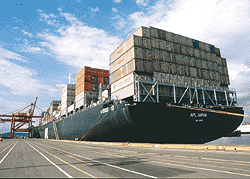Daniel P. Bearth
| Staff WriterCities, States Harbor Intermodal Hopes
Spurred by the promise of federal support and fed up with increased congestion at the nation’s ports and rail terminals, cities and states are working with the private sector to improve intermodal freight handling facilities throughout the country.
Dozens of ambitious new projects are on the drawing boards, but getting them built will not be easy. Despite the lofty policy goals outlined in the Intermodal Surface Transportation Efficiency Act of 1991, direct financial assistance from the federal government is quite limited, and nearly all freight projects will require major financial commitments from local and state governments and the private sector. Also, they must overcome major environmental and public relations hurdles to become a reality.
The $1.9 billion project is designed to accommodate the operations of freight railroads that serve the ports of Los Angeles and Long Beach, and to take intermodal traffic off the congested streets of the megalopolis. Upon completion in 2001, rail movements will shift to a single, 20-mile, high-capacity “trainway,” removing the need for trucks to haul ocean containers several miles between the ports and existing rail yards east of downtown Los Angeles.
For the full story, see the Apr. 10 print edition of Transport Topics. Subscribe today.
 |  Michael James - Transport Topics |
 | Facilities like the American President Lines terminal at Seattle inspire states and localities to work with the intermodal industry. |
Construction of the Alameda Corridor is perhaps the best example of the promise and pitfalls of trying to improve intermodal infrastructure.
 |

